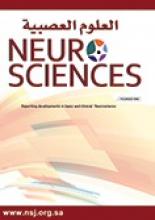Abstract
OBJECTIVE: To ascertain the prevalence of risk factors for ischemic stroke in Pakistani patients at Shifa International Hospital (SIH), Islamabad, Pakistan.
METHODS: This retrospective cross-sectional study included patients of either gender, with no age limit admitted to the Department of Neurology at Shifa International Hospital, Islamabad, Pakistan, with the diagnosis of stroke verified by brain CT scan during a period of 2 years from January 2007 to December 2009. The data were analyzed by grouping our patients according to their age based on the frequency of risk factors. Group 1; 25-55 years (23.8%), group 2; 56-71 years (43.4%), and group 3; 72-103 years (32.7%).
RESULTS: A total of 418 patients were included in the study; 137 patients were excluded due to incomplete information. The data from the remaining 281 were analyzed. The mean age of the population was 65+/-0.8 years, and the male to female ratio was 1.30:1. The most frequent risk factors included hypertension 86.8% followed by diabetes mellitus 59.8%, dyslipidemia 59.1%, and smoking 18.1%. The highest frequency of 4 risk factors was present in the age group 56-71. Gender distribution of risk factors showed that hypertension and dyslipidemia are major risk factors in group 1. Abnormal high-density lipoproteins (HDL) emerged as the major lipid among 3 groups, especially in group 1, which predisposed to stroke.
CONCLUSION: A decrease in HDL and control of blood pressure is important to reduce the risk of stroke especially in early age (namely, >/=25 years) and could become an increasingly useful tool to identify patients at a high risk of stroke.
- Copyright: © Neurosciences
Neurosciences is an Open Access journal and articles published are distributed under the terms of the Creative Commons Attribution-NonCommercial License (CC BY-NC). Readers may copy, distribute, and display the work for non-commercial purposes with the proper citation of the original work.






